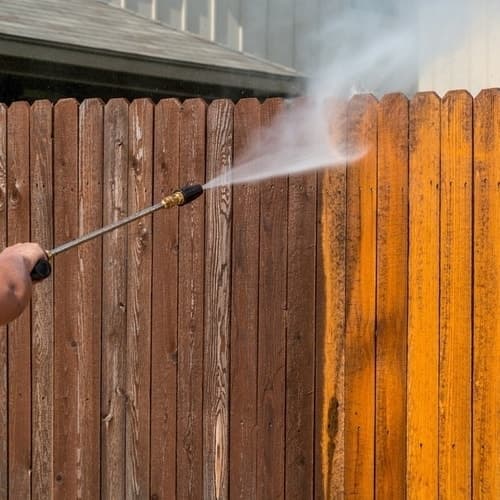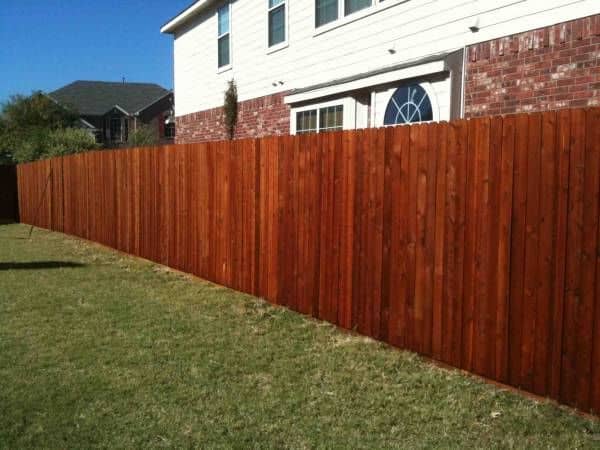Get Your Fence Summer-Ready with Top-Notch Fence Staining Services!
Get Your Fence Summer-Ready with Top-Notch Fence Staining Services!
Blog Article
Just How to Pick the Right Fence Stain for Your Home
When it pertains to boosting the look and resilience of your home's fence, picking the appropriate stain is a crucial decision that requires careful factor to consider. With a myriad of alternatives offered in the marketplace, each accommodating different wood kinds, colors, and openness levels, the procedure can quickly become frustrating. Nonetheless, making an informed option can dramatically affect the overall aesthetic appeals and long life of your fence. So, how can you make certain that you choose the ideal fencing stain that straightens with your home's design and maintenance demands? Allow's discover some vital elements to assist you in this decision-making process.
Comprehending Timber Types
To pick the ideal fencing discolor, it is essential to have a detailed understanding of the various types of wood frequently utilized for fencing. When selecting a fencing stain, it is important to think about the kind of timber being utilized to guarantee compatibility and ideal defense. Recognizing the characteristics of various wood kinds will assist you make a notified decision when it comes to selecting the ideal fence tarnish for your home.
Selecting the Right Color
Selecting a suitable shade for your fencing tarnish is a critical choice that considerably impacts the overall aesthetic appeal of your residential or commercial property. The shade you pick need to complement the style of your home, blend sympathetically with the environments, and show your individual preference. When selecting a shade, consider the existing shade palette of your building. For a natural look, natural tones like browns, eco-friendlies, or grays work well. These colors can help the fencing mix right into the landscape and produce a cohesive look. If you like a more modern or bold look, think about choosing darker tones like black or deep charcoal for a striking comparison. Lighter shades such as whites or light grays can make a fencing appear larger and add a touch of style to your residential property. Inevitably, the ideal shade selection will certainly improve the charm of your fence and raise the total aesthetic allure of your home.

Thinking About Openness Degrees
When selecting the appropriate color for your fencing tarnish, one more crucial aspect to think about is the level of transparency that will certainly best suit your residential or commercial property's aesthetic and maintenance needs. Openness levels in fence discolorations typically drop into three groups: transparent, semi-transparent, and solid. Transparent discolorations permit the natural beauty of the wood to show with while offering very little defense against the components. They are perfect for brand-new or well-kept fences where showcasing the wood grain is a concern. Semi-transparent discolorations supply an linked here equilibrium between shade enhancement and protection, permitting some timber grain to be visible while giving modest protecting from UV rays and dampness. Solid discolorations, on the various other hand, give the most defense as they completely cover the timber with an opaque surface. These appropriate for older fencings or those in need of significant protection or color change. Take into consideration the degree of direct exposure your fence faces, the desired upkeep frequency, and the visual you desire to attain when selecting the right openness level for your fence stain.
Reviewing Maintenance Demands
Taking into consideration the longevity and upkeep of your fencing, reviewing the maintenance demands is essential in establishing one of the most appropriate fence discolor for your building. The level of maintenance required for your fencing can vary relying on aspects such as the kind of timber, climate problems in your area, and your individual choices.
When examining upkeep requirements, it is necessary to think about the toughness of the fencing stain. Some spots need even more regular reapplication than others, so selecting a tarnish with a much longer life expectancy can help reduce the general upkeep requirements of your fence (Fence Staining). In addition, factors such as resistance to UV rays, water, and mildew can impact how frequently you need to re-stain your fencing

Examining Examples Before Application
Before using any type of fencing stain, it is suggested to carry out example examinations to guarantee compatibility with the wood and wanted visual end result. Checking examples allows you to assess exactly how the tarnish will engage with the certain type of wood made use of in your fencing, as various woods can soak up spots in different ways. To begin, select a tiny inconspicuous location of the fencing to apply the discolor samples.
Conclusion
Finally, choosing the appropriate fence discolor for your residential property includes recognizing the wood type, picking the best color, considering transparency levels, reviewing upkeep needs, and testing examples before application (Fence Staining). By taking these factors into consideration, you can ensure that your fencing tarnish complements your building while giving the necessary defense and durability. Make a notified choice to boost the appearance and longevity of your fencing
Report this page